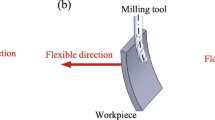Abstract
High-speed milling of thin-walled part is a widely used application for aerospace industry. The low rigidity components, large quantities of material removed in machining progress, are in the risk of the instability of the progress. In this paper, the thin-walled parts have the similar characteristics with the tools. Therefore, the dynamic model and the stability critical condition determined by the relative dynamic behavior between tool subsystem and workpiece subsystem are put forward. The thin-walled parts’ dynamic character varies greatly with time when machining. The whole workpiece has been divided into several stages by finite element analysis (FEA) so that its various modal parameters in the milling progress can be obtained gradually; thus, the variation due to metal removal has been accurately taken into account. The stability critical condition is predicted by frequency domain method based on the dynamic behavior of the two subsystems. With the respect to time-varying critical stability condition, a three-dimensional lobe diagram has been developed to show the changing conditions of chatter. Finally, the proposed methods and models were proven by series milling experiments.
Similar content being viewed by others
References
Budak E, Altintas Y (1998) Analytical prediction of chatter stability in milling—part I:general formulation. Trans ASME. J Dyn Syst Meas Control 1:22–30
Budak E, Altintas Y (1998) Analytical prediction of chatter stability in milling—part II: application of the general formulation to common milling systems. Trans ASME. J Dyn Syst Meas Control 120(1):31–36
Zhu LD, Li H, Wang W (2013) Research on rotary surface topography by orthogonal turn-milling. Int J Adv Manuf Tech 69(9–12):2279–2292
Wan M, Ma YC, Zhang WH, Yang Y (2015) Study on the construction mechanism of stability lobes in milling process with multiple modes. Int J Adv Manuf Tech 79(1–4):1–15
Bravo U, Altuzarra O, Lacalle LNLD, Sánchez JA, Campa FJ (2005) Stability limits of milling considering the flexibility of the workpiece and the machine. Int J Mach Tool Manu 45(15):1669–1680
Thevenot V, Arnaud L, Dessein G, Cazenave–Larroche G (2006) Influence of material removal on the dynamic behaviour of thin-walled peripheral milling. Mach Sci Technol 10(3):275–287
Thevenot V, Arnaud L, Dessein G, Cazenave–Larroche G (2006) Integration of dynamic behaviour variations in the stability lobes method: 3D lobes construction and application to thin-walled structure milling. Int J Adv Manuf Tech 27(7–8):638–644
Alan S, Budak E, Özgüven HN (2010) Analytical prediction of part dynamics for machining stability analysis. Int J Auto Tech 4(3):259–266
Schmitz TL, Davies MA, Kennedy MD (2001) Tool point frequency response prediction for high-speed machining by RCSA. J Manuf Sci E-T ASME 123(4):700–707
Wan M, Kilic ZM, Altintas Y (2015) Mechanics and dynamics of multifunctional tools. J Manuf Sci Eng 137(1)
Wan M, Ma YC, Feng J, Zhang WH (2016) Study of static and dynamic ploughing mechanisms by establishing generalized model with static milling forces. Int J Mech Sci 114:120–131
Wan M, Altintas Y (2014) Mechanics and dynamics of thread milling process. Int J Mach Tool Manu 87:16–26
Cao H, Li B, He Z, Li B (2013) Finite element model updating of machine-tool spindle systems. J Vib Acoust 135(2):77–82
Cao H, He Z, Li B (2012) Chatter stability of milling with speed-varying dynamics of spindles. Int J Mach Tool Manu 52(1):50–58
Author information
Authors and Affiliations
Corresponding author
Rights and permissions
About this article
Cite this article
Ding, Y., Zhu, L. Investigation on chatter stability of thin-walled parts considering its flexibility based on finite element analysis. Int J Adv Manuf Technol 94, 3173–3187 (2018). https://doi.org/10.1007/s00170-016-9471-x
Received:
Accepted:
Published:
Issue Date:
DOI: https://doi.org/10.1007/s00170-016-9471-x




